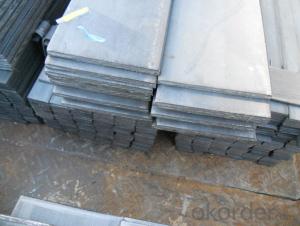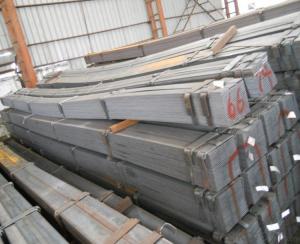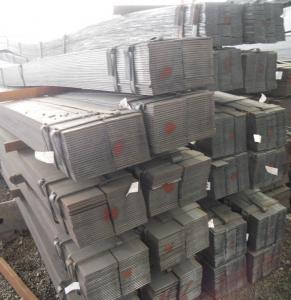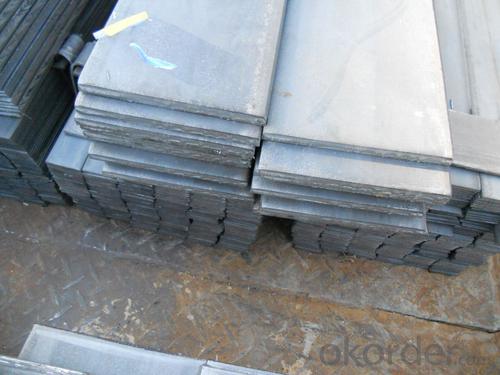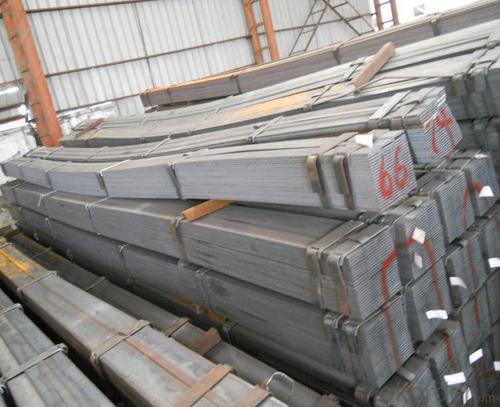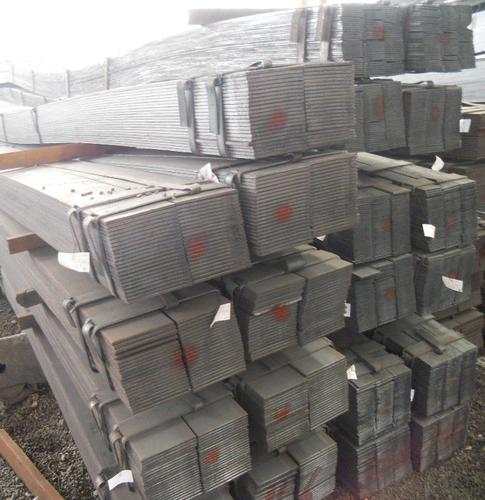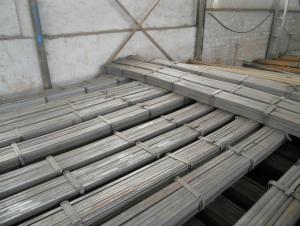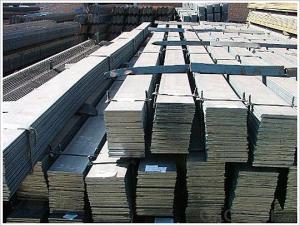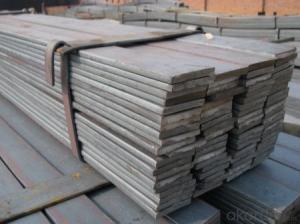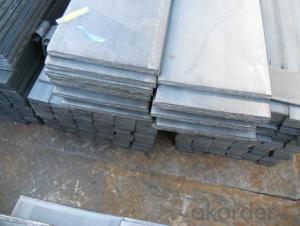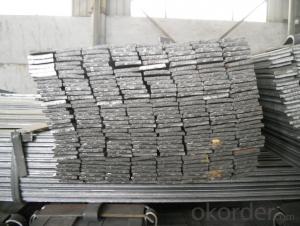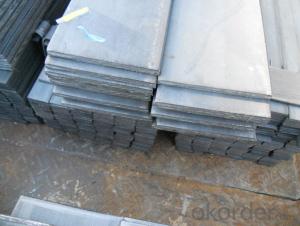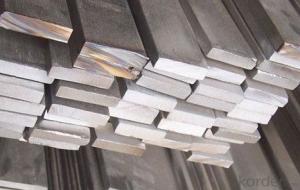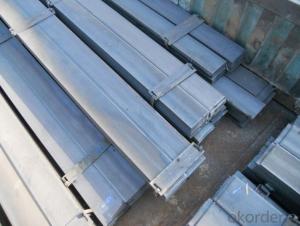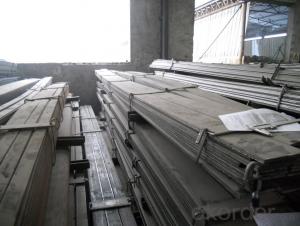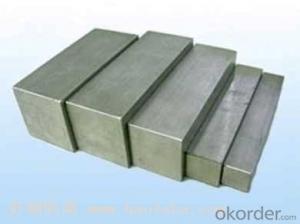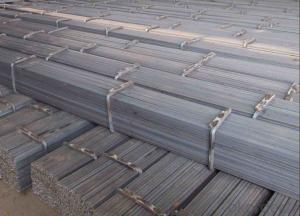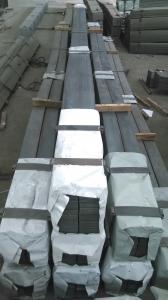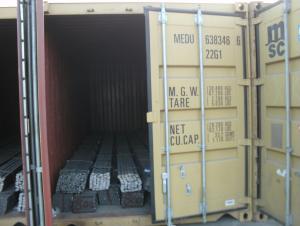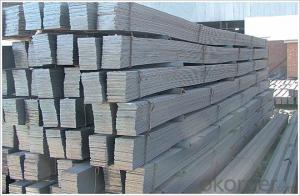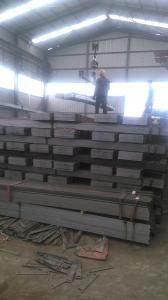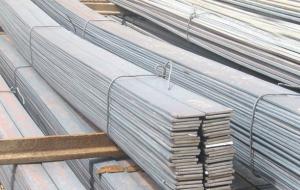High Quality Mild Steel Flat Bar in Grade Q235
- Loading Port:
- Tianjin
- Payment Terms:
- TT OR LC
- Min Order Qty:
- 25 m.t.
- Supply Capability:
- 100000 m.t./month
OKorder Service Pledge
OKorder Financial Service
You Might Also Like
Specification of Steel Flat Bar
Commodity: Carbon Steel Flat Bar
Standard: GB,JIS,ASTM,
Material: Q235,SS400 or Equivalent
Brand name: FLATSPACE
Origin place: China
Thickness: 3mm-30mm
Width:20mm-200mm
Length: Max 12m
Certification: SGS/BV
Chemical composition of Q235
Alloy No | Grade | Element(%) | ||||
C
| Mn
| S
| P
| Si
| ||
Q235
|
B
|
0.12—0.20 |
0.3—0.7 |
≤0.045 |
≤0.045
|
≤0.3
|
Physical properties of Q235
Alloy No | Grade | Yielding strength point(Mpa) | Tensile strength (Mpa) | Elongation after fracture(%) | ||||||
Thickness (mm) | Thickness (mm) | |||||||||
≤16 | >16--40 | >40--60 | >60--100 | ≤16 | >16--40 | >40--60 | >60--100 | |||
≥ | ≥ | |||||||||
Q235 |
B |
235 |
225 |
215 |
205 |
375--500 |
26 |
25 |
24 |
23 |
Above sheets show the technical data of Q235,we can also provide other materials similar to Q235.
Usage/Applications of Steel Flat Bar
Widely used for construction;
Machinery manufacturing;
Iron tower steel structure;
Shipbuilding; Steel grating;
Staircase;
Bridge;
Viaduct;
Railway spare parts;
Boilers making etc.
Packaging & Delivery of Steel Flat Bar
Packaging Details: The Steel Flat Bars are packed in bundles and loaded in 20 feet/40 feet container, or shipped by bulk cargo ,also we can do as customer's requirements.
Delivery Details:30~45 days upon the receipt of buyer payment by T.T. or L/C.
- Q: How do you store and transport steel flat bars safely?
- To store and transport steel flat bars safely, there are several key steps to follow: 1. Proper stacking: When storing steel flat bars, it is important to stack them properly to prevent any damage. Ensure that the bars are stacked horizontally and evenly, with each layer aligned. The weight should be distributed evenly across the stack to maintain structural integrity. 2. Adequate support: Use sturdy supports such as appropriately sized pallets or racks to prevent any sagging or bending of the bars. Make sure that the supports are capable of handling the weight and size of the steel flat bars. 3. Securing the stack: To prevent the bars from shifting during transportation, it is necessary to secure the stack using straps or bands. These should be tightly fastened around the stack, ensuring that the bars are secure and won't move during transit. 4. Protective measures: Steel flat bars are susceptible to corrosion, especially when exposed to moisture. Therefore, it is crucial to protect them from environmental elements during storage and transportation. Consider using protective covers or wrapping the bars in moisture-resistant materials to prevent rust or damage. 5. Proper lifting and handling: When moving steel flat bars, it is important to use appropriate lifting equipment, such as forklifts or cranes, to avoid any injuries or accidents. Ensure that the lifting equipment is capable of handling the weight of the bars and that operators are well-trained in safe lifting practices. 6. Special considerations for long-distance transportation: If transporting steel flat bars over long distances, it may be necessary to use specialized shipping containers or trucks that are equipped to handle heavy loads and provide adequate protection from external elements. Overall, the key to safe storage and transportation of steel flat bars lies in proper stacking, adequate support, securing the stack, protective measures, and employing the right lifting and handling techniques. Adhering to these guidelines will help minimize the risk of damage, accidents, and corrosion, ensuring the safe delivery of steel flat bars to their destination.
- Q: Are steel flat bars used in the aerospace industry?
- Yes, steel flat bars are commonly used in the aerospace industry. Steel is known for its strength and durability, making it an ideal material for various applications in aerospace engineering. Steel flat bars are often used in the manufacturing of aircraft components such as brackets, frames, and supports. These bars provide structural stability and support, ensuring the integrity and safety of the aircraft. Additionally, steel flat bars offer excellent resistance to corrosion and high temperatures, which are essential qualities for aerospace applications. Overall, steel flat bars are an essential material in the aerospace industry, playing a crucial role in the construction and performance of aircraft.
- Q: Can steel flat bars be used for making furniture frames or supports?
- Certainly, furniture frames or supports can indeed be constructed using steel flat bars. Steel, being a versatile and durable material, offers exceptional strength and stability, making it an ideal choice for furniture manufacturing. Steel flat bars provide a solid foundation and structural integrity to furniture frames or supports, guaranteeing durability and stability. Moreover, steel can be easily shaped and welded, allowing for design flexibility and customization. It is commonly employed in the construction of various furniture pieces such as tables, chairs, shelving units, and bed frames. In summary, steel flat bars are a dependable option for furniture frames or supports, offering a robust and enduring solution.
- Q: The difference between galvanized flat steel 40*4 and galvanized flat steel 80*8 is the difference on the material list!
- Here, your galvanized flat steel refers to the basic matrix is carbon content less than 0.18% carbon steel (Q235), after galvanizing (general hot plating), play the role of surface oxidation resistance, corrosion resistance. Generally used in the power sector, what you mention is the difference in size.
- Q: How do you protect steel flat bars from chemical corrosion?
- To protect steel flat bars from chemical corrosion, there are several effective methods that can be employed. 1. Coating: Applying a protective coating is one of the most common methods to prevent chemical corrosion. There are various types of coatings available, such as paint, epoxy, enamel, or polyurethane. These coatings act as a barrier between the steel surface and the corrosive chemicals, preventing direct contact and thus reducing the risk of corrosion. It is important to choose a coating that is specifically designed for chemical resistance and to ensure proper application for maximum effectiveness. 2. Galvanization: Galvanizing steel flat bars involves applying a layer of zinc to the surface. This process creates a protective barrier that shields the steel from corrosive substances. Hot-dip galvanizing is a widely used method where the steel is immersed in molten zinc, allowing a thick and durable coating to form. Galvanized steel flat bars are highly resistant to chemical corrosion and can provide long-lasting protection. 3. Stainless steel: Using stainless steel flat bars that contain a high percentage of chromium and nickel can greatly enhance their resistance to chemical corrosion. The addition of these elements forms a passive layer on the surface that acts as a protective barrier against corrosive chemicals. Stainless steel is particularly suitable for applications where exposure to aggressive chemicals is expected. 4. Proper storage and handling: Ensuring proper storage and handling practices is essential in protecting steel flat bars from chemical corrosion. Storing them in a dry and well-ventilated area, away from corrosive substances, can help prevent direct exposure. Additionally, using protective covers or wrapping the bars in moisture-resistant materials can provide an extra layer of defense. Regular inspection and maintenance are also important to detect any signs of corrosion early. If any damage or deterioration is identified, prompt repairs or replacements should be carried out to maintain the integrity and longevity of the steel flat bars.
- Q: Are there any differences between flat iron and flat steel?
- The steel and iron are carried out using redox reaction, but there is a great difference in the response object: iron is iron reduced, while steel is the excess carbon in pig iron and other impurities in the actual operation, so the two links are different.There are three main ways to make steel: converter, electric furnace and peace furnace. Among them, the converter steelmaking method is more common. We do not need to remember its specific operations (but only to lead to understanding), but attention should be paid to reactions such as ferric oxide, removal of magazines and deoxygenation. A large amount of brown vapor is produced during steelmaking, consisting of iron oxides, dust particles, and high concentrations of carbon monoxide, which must be purified.
- Q: Are steel flat bars prone to warping or bending?
- Yes, steel flat bars are prone to warping or bending under certain conditions.
- Q: Can steel flat bars be used for making hand tools or gardening equipment?
- Absolutely, steel flat bars are ideal for crafting hand tools and gardening equipment. Steel, renowned for its strength and durability, is widely employed in the production of diverse tools and equipment. The malleability of steel flat bars enables effortless shaping and customization to cater to the particular requirements of hand tools and gardening equipment. These bars can be utilized for fabricating handles, blades, brackets, or any other necessary component in these applications. Moreover, steel flat bars boast corrosion resistance and can endure rigorous use, rendering them perfect for tools and equipment that are exposed to outdoor elements or demanding gardening tasks.
- Q: Can lightning protection earthing steel bar be directly welded with thread steel?
- Steel is known as hot rolled ribbed bar. Ordinary hot rolled steel bars are made up of HRB and the minimum yield point of the brand. H, R, and B are the first letters in English for hot-rolled (Hotrolled), ribbed (Ribbed) and reinforced (Bars) three words. Hot rolled ribbed bar is divided into two levels, HRB335 (old No. 20MnSi), three HRB400 (20MnSiV, 20MnSiNb, old No. 20Mnti), four grade HRB500 three grade.
- Q: What is the maximum length available for steel flat bars?
- The length of steel flat bars can differ depending on the supplier and manufacturer. Nonetheless, standard lengths of 20 feet or 6 meters are typically produced for steel flat bars. These lengths are readily accessible and appropriate for various applications. Furthermore, it is important to mention that certain suppliers offer tailored cutting services, enabling customers to specify desired lengths based on their project needs.
Send your message to us
High Quality Mild Steel Flat Bar in Grade Q235
- Loading Port:
- Tianjin
- Payment Terms:
- TT OR LC
- Min Order Qty:
- 25 m.t.
- Supply Capability:
- 100000 m.t./month
OKorder Service Pledge
OKorder Financial Service
Similar products
Hot products
Hot Searches
Related keywords
